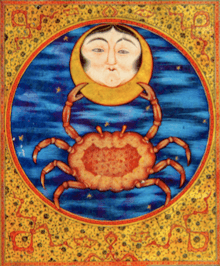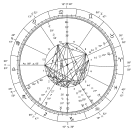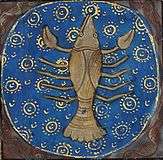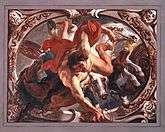Cancer (astrology)
| Cancer | |
|---|---|
 | |
|
| |
| Zodiac symbol | Crab |
| Duration (tropical, western) | June 21 – July 22 (2018, UT1)[1] |
| Constellation | Cancer |
| Zodiac element | Water |
| Zodiac quality | Cardinal |
| Sign ruler | Moon |
| Detriment | Saturn, Uranus |
| Exaltation | Jupiter |
| Fall | Mars |
|
| |
| Astrology |
|---|
 New millennium astrological chart |
| Background |
| Traditions |
| Branches |
|
|
Cancer (♋️) is the fourth astrological sign in the Zodiac, originating from the constellation of Cancer. It spans 90° and 120° celestial longitude. Under the tropical zodiac, the Sun transits this area between approximately June 21 and July 23,[2] and under the sidereal zodiac, the Sun transits this area between approximately July 16 and August 15.[3]
In astrology, Cancer is the cardinal sign of the Water trigon, which is made up of Cancer, Pisces, and Scorpio.[4] It is considered a negative sign, whose domicile, or ruling planet, is the Moon. Though some depictions of Cancer feature a lobster, the sign is most often represented by the crab, based on the Karkinos, a giant crab that harassed Heracles during his fight with the Hydra.[5]
Astrology
Those who are born from approximately June 22 to July 22 are born under Cancer.[6] Individuals born during these dates, depending on which system of astrology they subscribe to, may be called "Cancerians."[7] Cancer is a northern sign and its opposite sign is Capricorn.[8][9][10] Cancer is a cardinal sign.
Along with Scorpio and Pisces, Cancer forms the Water Trigon.[11] The Water Trigon is one of four elemental trigons, fire, earth, air, and water.[12] When a trigon is influential, it affects changes on earth.[12] Cancer is said to be the house of Neptune and the exaltation of Jupiter, both astronomical bodies having influence over those born under Cancer.[8][9] In Vedic astrology the sign is named Karka and its Lord is Moon.[13]
In ancient times, Cancer was known as the "dark sign" because of the obscured visibility of its constellation in the night sky.[14]
Mythology
Greek mythology
The story of Cancer the Crab is said to be connected to Heracles.[15] Some storytellers say that during Heracles' fight with Lernaean Hydra, Hera, sent a crab from a swamp to snap at Heracles' toes because Hera had sworn to kill Heracles.[16][17] Heracles was able to kill the crab by smashing its shell with his foot.[18] As a reward for its efforts serving her, Hera placed the crab in the sky and it became Cancer.[18]
Chinese mythology
In Chinese star lore, Cancer is in the 23rd of the 28 mansions or xiu.[19] This mansion is called Gui which roughly translates to "ghosts".[19] The Chinese divided the sky into four quarters, each with its own direction, season, and mythical creature. Cancer exists in the Red (Vermillion) Bird of the south. It is associated with summer.[19]
In the arts
In Dante's Paradiso, he makes reference to Cancer, writing:
Thereafterward a light among them brightened,
So that, if Cancer one such crystal had,
Winter would have a month of one sole day.
Cancer is figured in Giovanni Maria Falconetto's 1517 painting, Cancer, as the guardian of the city of Verona.[21] The Cancer symbol is also depicted in Agostino di Duccio's sculpture View of Rimini Under the Sign of Cancer (1450).[22]
Gallery



.jpg)
References
Notes
- ↑ Astronomical Applications Department 2011.
- ↑ Oxford n.d., s.v. Cancer, Leo.
- ↑ Amao 2016, p. 70.
- ↑ Shoemaker 1904, p. 45.
- ↑ Atsma c. 2015.
- ↑ Encyclopædia Britannica 2014.
- ↑ Oxford n.d., s.v. cancrian.
- 1 2 Smith 1828, p. 64
- 1 2 Lilly 1835, pp. 14, 60
- ↑ Simmonite 1896, p. 17.
- ↑ Allen 1899, p. 107
- 1 2 Harkness 1999
- ↑ Charak 1996, p. 12.
- ↑ Chwalkowski 2016, p. 453.
- ↑ Cancer horoscope n.d.
- ↑ French 2001, p. 93
- ↑ Andrews 2000, p. 30.
- 1 2 Cancer n.d.
- 1 2 3 Ridpath n.d.
- ↑ Allen 1899, p. 109.
- ↑ Battistini 2007, p. 47.
- ↑ Battistini 2007, p. 46.
Sources
- Allen, Richard Hinckley (1899). Star-names and Their Meanings. G.E. Stechert.
- Amao, Albert (2016). The Birth of a New Consciousness and the Cycles of Time. AuthorHouse. ISBN 978-1-504-97542-1.
- Andrews, Tamra (2000). Dictionary of Nature Myths: Legends of the Earth, Sea, and Sky. Oxford University Press. ISBN 978-0-195-13677-7.
- Astronomical Applications Department (2011). Multiyear Computer Interactive Almanac. 2.2.2. Washington DC: US Naval Observatory. Longitude of Sun, apparent geocentric ecliptic of date, interpolated to find time of crossing 0°, 30°....
- Atsma, Aaron J. (c. 2015). "CARCINUS : Giant crab of Lerna". Theoi Project. Retrieved December 29, 2016.
- Battistini, Matilde (2007). Astrology, Magic, and Alchemy in Art (A Guide to Imagery). J. Paul Getty Museum. ISBN 978-0-892-36907-2.
- "Cancer horoscope". Stung Limited. Retrieved May 19, 2016.
- "Cancer". Encyclopædia Britannica. 2014. Retrieved November 11, 2014.
- "Cancer". Windows to the Universe. n.d. Retrieved November 11, 2014.
- Charak, K.S. (1996). "Elements of Vedic Astrology". 1. Systems Vision. ISBN 9788190100809.
- French, Sue (March 2001). "What a Crab!". Sky & Telescope. 101 (3). Retrieved November 11, 2014.
- Chwalkowski, Farrin (2016). Symbols in Arts, Religion and Culture: The Soul of Nature. Cambridge Scholars Publishing. ISBN 978-1-4438-9957-4.
- Harkness, Deborah E. (1999). John Dee's Conversations with Angels: Cabala, Alchemy, and the End of Nature. Cambridge University Press. p. 70. ISBN 9780521622288. Retrieved November 11, 2014.
- Lilly, William (1835). An introduction to astrology, rules for the practice of horary astrology [an abstract of Christian astrology]: to which are added, numerous emendations, by Zadkiel. Oxford University. Retrieved November 11, 2014.
- "Oxford Dictionaries". Oxford University Press. Retrieved May 5, 2018.
- Ridpath, Ian (n.d.). "Charting the Chinese Sky". Ian Ridpath. Retrieved November 11, 2014.
- Shoemaker, Mrs. Mabel (McGeorge) (1904). Astrology. Penn Publishing Company. Retrieved October 28, 2014.
- Simmonite, William Joseph (2015) [1896]. Horary Astrology: The Key To Scientific Prediction, Being The Prognostic Astronomer. Andesite Press [Harvard College Library]. ISBN 978-1-296-83282-7.
- Smith, Robert Cross (1828). A Manual of Astrology, by Raphael. Oxford University.
External links
| Wikimedia Commons has media related to Cancer (astrology). |


- Warburg Institute Iconographic Database (over 300 medieval and early modern images of Cancer)